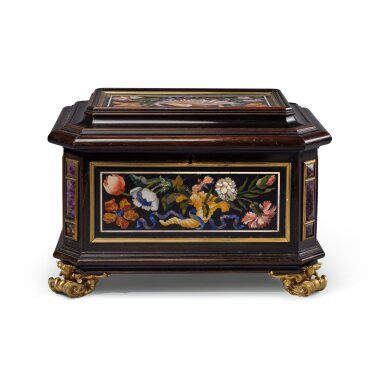
Property of a Distinguished Private Collection
An Italian Gilt-Bronze and Amethyst Mounted Pietre Dure and Ebony Casket, Florentine, Grand Ducal Workshops, Late 17th/Early 18th Century
Lot Closed
October 17, 06:25 PM GMT
Estimate
60,000 - 100,000 USD
Lot Details
Description
An Italian Gilt-Bronze and Amethyst Mounted Pietre Dure and Ebony Casket, Florentine, Grand Ducal Workshops, Late 17th/Early 18th Century
The wood case veneered in ebony, mounted on all four sides and the lid with rectangular hardstone plaques inlaid in lapis, agate and marble with flowers and insects interlaced with lapis lazuli ribbons, springing from agate shells within gilt-bronze frames, the faceted corners with amethystine quartz, scrolling ormolu feet, plain interior, veneered in ebony-banded olive wood reserves, steel hinges and lock plate with key.
height 11 1/4 in.; width 16 1/2 in.; depth 12 in.
28.5 cm; 42 cm; 30.5 cm
Sotheby's London, 6 July 2007, lot 90
A. M. Giusti, P. Mazzoni & A. P. Pampelloni Martelli, Il Museo dell'Opificio delle Pietre Dure a Firenze, Milan 1978)
A. Gonzalez-Palacios, Il Tempio del Gusto: La Toscana e l'Italia Settentrionale, Milan, 1984, vol.I, p.43 and vol.II , nos. 63-66
S. Jervis, 'Pietre Dure Caskets in England', Furniture History XLIII (2007), p.245-65
K.Lankheit, Florentinische Barockplastik, Munich 1962
A. M. Massinelli, The Gilbert Collection Hardstones, London, 2000, 9-20, no. 3
A product of the Florentine Grand Ducal workshops of the late seventeenth and early eighteenth century, this type of craftsmanship combined the earlier Roman taste for pietre tenere mosaic with Milanese hardstone sculpture. The primary objective of the workshop which comprised artists, architects, painters, stone carvers and metal-smiths was to manufacture opulent furnishings for the Grand Duke's residences and to distribute to foreign royalty as ambassadorial gifts. The court workshop had been set up in the Casino di San Marco, moved to the Uffizi in 1586 and during the seventeenth century continued to develop; it is during this period that we see a stylistic development in Florentine craftsmanship, from the intricacy of Mannerist designs to the bold drama of the Baroque.
Giovanni Battista Foggini (1652-1725) was director of the Florentine Grand Ducal workshops under Duke Cosimo II (1670-1723). Drawings by Foggini in the Giornale of the workshop now in the Uffizi and illustrated by Lankheit and Gonzalez-Palacios show designs for caskets and gilt bronze mounts which can be closely associated with the present finely detailed scroll mounts. From the time of their creation these caskets were actively acquired for princely and aristocratic collections, and examples related to the offered lot include one in the Corsini Collection, Florence (illustrated in Gonzalez-Palacios, fig.63) and another at Charlecote Manor, Warwickshire (illustrated Jervis, fig. 11).
You May Also Like










